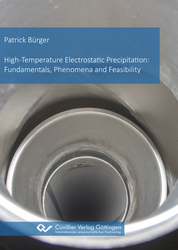| Areas | |
|---|---|
| Serie de libros (96) |
1378
|
| Nachhaltigkeit |
3
|
| Gesundheitswesen |
1
|
| Letra |
2363
|
| Ciencias Naturales |
5406
|
| Ciencias Ingeniería |
1791
|
| Ingeniería | 292 |
| Ingeniería mecánica y de proceso | 861 |
| Ingeniería eléctrica | 686 |
| Mineria y metalurgía | 30 |
| Arquitectura e ingeniería civil | 75 |
| General |
98
|
|
Leitlinien Unfallchirurgie
5. Auflage bestellen |
|
Erweiterte Suche
High-Temperature Electrostatic Precipitation: Fundamentals, Phenomena and Feasibility (Tienda española)
Patrick Bürger (Autor)Previo
Lectura de prueba, PDF (390 KB)
Indice, PDF (72 KB)
Particle separation from hot gases is a challenging task, especially for nanoparticles. Therefore, it is usually avoided by quenching the hot gas to conduct particle separation at a more convenient temperature. In these cases, valuable high-caloric heat is either not utilized at all or only inefficiently because of particle deposition on the heat exchanger surfaces. Valuable potential is thus wasted, as high-temperature processes are already an essential part of many industries and become increasingly relevant for other industrial sectors (e.g., pyrolytic processes in the circular economy). To reduce operating costs and environmental impact, the efficient use of resources (especially fossil fuels) is an absolute necessity.
To tackle this pending problem, the concept of high-temperature electrostatic precipitation is investigated in this doctoral thesis. In an electrostatic precipitator, particles are charged by charge carriers produced in a corona discharge near the discharge electrode. Charged particles migrate due to the electric field and subsequently precipitate onto the collection electrode.
This doctoral thesis clearly demonstrates the feasibility of nanoparticle removal from hot gases at up to 1073 K (800 °C) using electrostatic precipitation while presenting novel insights into the charge carrier properties and their distribution, the influence of thermionic emission on the operation of electrostatic precipitators, and the fundamentals of particle charging at high temperatures.
| ISBN-13 (Impresion) | 9783736978393 |
| ISBN-13 (E-Book) | 9783736968394 |
| Formato | B5 |
| Idioma | Inglés |
| Numero de paginas | 220 |
| Laminacion de la cubierta | mate |
| Edicion | 1. |
| Lugar de publicacion | Göttingen |
| Lugar de la disertacion | Brandenburgische Technische Universität Cottbus-Senftenberg |
| Fecha de publicacion | 03.07.2023 |
| Clasificacion simple | Tesis doctoral |
| Area |
Ingeniería
|
| Palabras claves | Heißgasreinigung, Gasreinigung, Partikelabscheidung, Aerosolabscheidung, Elektrostatische Abscheidung, Elektroabscheider, Elektrofilter, Sprühelektrode, Niederschlagselektrode, Strom-Spannungskennlinie, Koronaentladung, Einsatzspannung, Peek Gleichung, Townsend Gleichung, Gasionen, Ionenmobilität, Ionenalter, Cluster-Ionen, Freie Elektronen, Ladungsträgerverteilung, Elektronenreichweite, Ionenkonzentration, Elektronenkonzentration, Ionisationskoeffizient, Anheftungskoeffizient, Elektronenanheftung, Elektron-Partikel-Anheftungskoeffizient, Verbesserte Wärmerückgewinnung, Fraktionierte Partikelabscheidung, Effiziente Partikelabscheidung, Dekarbonisierung industrieller Prozesse, Nanopartikel, Eisenoxidpartikel, Fe2O3 Nanopartikel, Aerosol, Partikelgrößenverteilung, Partikelmobilitätsverteilung, Gleichgewichtsladungsverteilung, Partikelladung, Partikelladungszustand, Sättigungsladung, Staubschicht, Abscheidegrad, Trenngrad, Raumladung, Elektrische Mobilität, Aufladekinetik, Partikelaufladung, Diffusionsaufladung, Feldaufladung, Elektronische Aufladung, Elektronentemperatur, Thermionische Emission, Deutsch Gleichung, Prozesssimulation, Simulation, Modell, Staubhaltiges Gas, Heißes Gas, Luft, Verbrennungsabgas, Abgas, Technischer Stickstoff, Atmosphärendruck, High-temperature gas cleaning, Gas cleaning, Particle separation, Particle removal, Aerosol removal, Electrostatic precipitation, Electrostatic precipitator, ESP, Discharge electrode, Collection electrode, Current-voltage characteristics, Corona discharge, Onset voltage, Peek equation, Townsend equation, Gas ions, Ion mobility, Ion age, Cluster ion formation, Free electrons, Charge carrier distribution, Reach of free electrons, Ion concentration, Free electron concentration, Ionization coefficient, Attachment coefficient, Electron attachment, Electron accommodation coefficient, Intensification of heat recovery, Fractionated particle separation, Efficient particle separation, Decarbonization of industrial processes, Nanoparticle, Iron oxide particles, Fe2O3 nanoparticles, Aerosol, Particle size distribution, Particle mobility distribution, Equilibrium charge distribution, Particle charge, Particle charging state, Saturation charge, Dust layer, Separation efficiency, Space charge density, Electric mobility, Charging kinetic, Diffusion charging, Field charging, Electronic charging, Electron temperature, Thermionic emission, Deutsch equation, Process modelling, Simulation, Process model, Dusty gas, Hot gas, Air, Exhaust gas, Flue gas, Technical nitrogen, Ambient pressure, Atmospheric pressure, |
Rezension
This work on High Temperature Electrostatic Precipitation is remarkable for three major reasons:
First, the author gives the proof, on a semi-technical scale, that electrostatic precipitators can be operated successfully in the temperature range of up to 800 °C. Second, the author provides us with a lot of new, physics-based insights into corona discharges at high temperature. Notably, this includes a wealth of high-quality experimental data on gas ion mobilities, the occurrence of free electrons and aerosol charging kinetics. And last but not least, the author demonstrates that simple but intelligent modelling tools enable the simulation of high temperature precipitators on a standard PC.
Highly recommended to everyone working in the field of electrostatic precipitation…
Prof. Dr.-Ing. Ulrich Riebel
Lehrstuhl Mechanische Verfahrenstechnik
Brandenburgische Technische Universität Cottbus-Senftenberg








